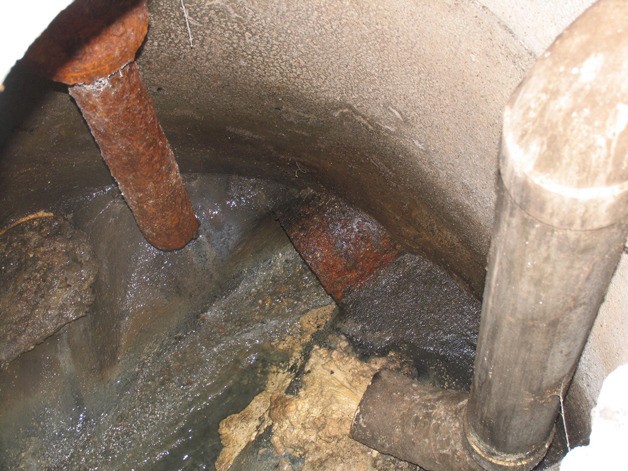Aging, leaky pipes and facilities have created a foul scenario for Langley’s sewer system, and the fix is going to be a painful process of rate hikes.
Nearly $2 million worth of repairs and improvements to be made over the next 20 years were identified by a consulting group charged with creating the city’s six-year sewer comprehensive plan. A representative with the firm outlined potential rate structures to fund the fixes, the most aggressive of which would more than double rates in just six years, from $168 every two months in the the first year to $360 by 2021.
No decisions were made, but city officials say something will need to be done. Rates have increased for the past several years, but it simply wasn’t enough and Langley may be at a reckoning.
“It appears we’ve kicked the can a number of years,” Mayor Tim Callison said. “It may not be the end of the road, but it’s close.”
Paul Weller, a senior planner with PACE, told the council that inflow and infiltration from cracks, poor connections and roots in places are adding ground water to the sewer system, putting an undue burden on the treatment facility on Coles Road. Years ago, the city had an inspection of its sewer lines that revealed the problems and allowed a map to be created for PACE to outline what needs to be done, when and how. Once repairs and improvements are made, ongoing and maintenance will help prevent further issues, Weller said.
“All of these have costs associated with them,” Weller said as he described some of the 31 capital improvement projects in the general sewer system plan.
The city gets funds for its utility services through a few major sources: rates, new connections and grants. Without any grants in the funding pipeline and with a modest expected population growth of 89 more residents over the next two decades, that means the burden for payment may fall heaviest on residents’ sewer rates. Councilwoman Dominique Emerson pointed out that the financing plan prepared by a separate consulting group was based on an annual average of three new home connections, despite having 15 in the past year.
“We don’t want to rely on growth we can’t say will be there,” said Katy Isaksen, the utilities financing contractor of Katy Isaksen & Associates.
The general sewer system plan outlined what needed to be done with a broad timetable of immediate, near term, long term and ongoing designations for when the projects needed to be addressed. The financial plan proposed a handful of strategies for paying for them, varying from a do-nothing, “kick the can” approach, to an aggressive path for paying for all of it as soon as possible.
Isaksen prefaced the proposed rates in her financial presentation as being “potential” and “very preliminary.” She still needed council direction and other data to fine tune what homeowners may pay at the tap. Keeping funding as is while pursuing the improvements would mean an increase of $66 in the first year for an average single-family residence, followed by no more than $20 annually in the next five years. Pursuing the aggressive capital improvement projects timeline could mean an initial 105 percent rate increase, bumping the two-month bill to $168 the first year, up to $360 by 2021. Such dramatic increases were sure to invoke disagreement and discontent among residents, Councilman Thomas Gill said.
“It’s an eye opener for me to see what kind of deficits we’re facing,” he said, adding that the city could get a large chunk of its financing through new hookups by existing residences still using individual septic systems.
The city last completed its sewer plan in 2009, at which time the council approved annual rate increases based upon the consultants’ recommendation. Councilwoman Rene Neff, the only current council member who served then, asked why the city is again facing this issue of utility deficits.
Randi Perry, Langley utilities supervisor, said most of the capital improvement projects on the current list where on the same list seven years ago. But, because other issues arose that needed funding, and the rates were not enough to cover everything, the projects were shelved.
Also, higher projections for population growth, and thus new connections and added monthly users, may have led to a false accounting for revenue.
According to the PACE report, 60 percent of Langley’s population is served by nearly seven miles of city sewer lines. Langley went through about 76,100 gallons of sewage per day in 2014. The sewer treatment plant can handle 150,000 gallons per day.
Average American household use, according to the U.S. Environmental Protection Agency, is 100 gallons of water per person per day. The national wastewater target, however, is about 40-60 gallons per person per day.
Finding ways to fund infrastructure — sewer, water, storm water, street — improvements is a challenge facing the United States as a whole. With major work done after World War II, some of those projects are now showing their age, such as bridges falling, lead poisoning, etc.
“It’s an issue across the country where infrastructure is failing,” Neff said.
In Langley, the burden is likely to fall on residents who will see their rates sharply increase in the years to come. The council did not vote on either the sewer projects plan or financing plan, and will revisit the issue at a later meeting.



